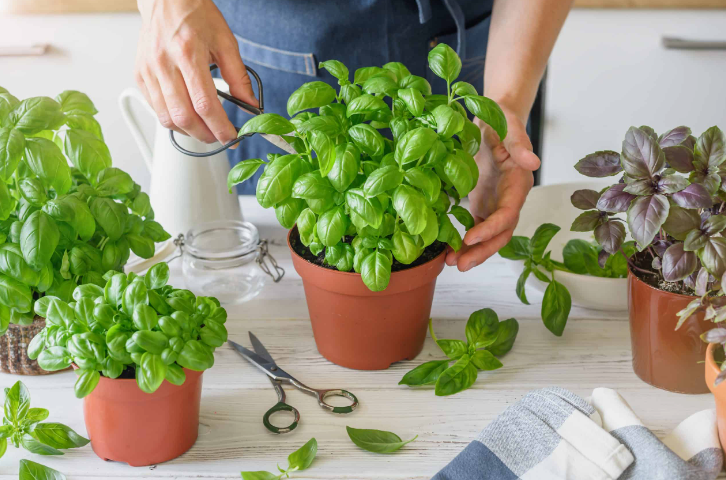Does Basil Regrow Once Cut? How to Get Bushy Basil

Nothing makes me more excited for summer than the scent of fresh basil! This versatile herb is one of my favorites and incredibly easy to cultivate. One of the great features of basil is that basil regrows after you cut it! With proper care and pruning, this beautiful plant can grow into an impressive bushy plant supplying you with delicious basil all summer long! We will cover will basil grow back after cutting? and how to harvest and prune basil so it forms into a full bushy plant that meets your expectations. We’ll also discuss what should be done if your basil starts flowering prematurely.
How to Cut Basil So Basil Regrows
are you worried about does basil grow back after you cut it? Basil can be harvested quickly and easily, with two methods available depending on your harvest needs. However, be wary not to cut it too close to its base level or you risk significantly hindering its development!
If you need only a small amount of basil, simply pull some leaves off of the plant with your fingers. Take extra care to pinch each leaf at its base where it joins with the plant, otherwise you risk accidentally ripping or breaking off either its leaf or stem!
If you want to harvest large amounts of basil at one time, the fastest and easiest way is to cut whole stems off using garden shears or sharp scissors. Make sure your cuts fall just above any nodes where two leaves emerge from a single stem.
Once you’ve harvested a beautiful bouquet of basil, be sure to store it in a glass of water to protect it from wilting. As basil does not tolerate cold temperatures well, do not place it in the refrigerator as this may lead to brown spots appearing on its leaves.
When to Harvest Basil?
Your basil should be ready for harvest once it reaches six inches in height, though as previously stated it’s cold-sensitive so this could take until summer depending on which agricultural zone it’s growing in.
Most likely, this means harvesting their basil by May or June. As it regrows quickly, harvest will likely take place shortly thereafter and continue growing up until frost kills it off.
At its height in summer, you can harvest your basil plants once or more every week. One plant may even suffice for our household needs!
Pruning Basil:
Pruning basil is similar to harvesting it; you’ll need sharp shears and something suitable to store your freshly pruned basil stems until later.
As with harvesting, begin by pruning only the top two inches of basil plants. Overdoing pruning could result in accidentally trimming too much. When harvesting basil plants for harvesting purposes, cut stems just above where two leaves sprout from one stem node – this point is known as “node”.
Always start from the top when pruning, as the larger lower leaves provide most of the photosynthesizing and producing energy for your plants. Cutting them from their source could impede their development.
As we discussed in our article on leggy basil, trimming back your plant will cause two new shoots to start growing back at each location, effectively doubling your crop!
Pruning from your plant are still edible and should not go to waste! If you have too much basil than can be consumed at one time, processing it into pesto may be a great way to utilize its resources while simultaneously storing well in the freezer. Leggy basil can even be processed into pesto for storage in this way!

Leggy Basil
Sometimes young basil plants may start out leggy and not form the big bushy plant that you expect them to.
Basil can become leggy when its stems begin to become long but thin, typically as young seedlings don’t receive enough sunlight and try to stretch toward whatever little illumination there may be.
Leggy basil plants should not be grown as their long thin stems are less sturdy and therefore more likely to bend or break under the weight of their foliage or during weather-related events.
Once your leggy basil has been moved to an area with better lighting conditions, pruning back the leggy stems can help it flourish back into a healthy bushy plant again. We have an article dedicated to leggy basil care that you can view here.
Can You Harvest Basil After it Flowers?
Once basil flowers, this indicates its lifecycle is almost at an end and that seeds and reproduction will occur before its demise. When this occurs, harvest it quickly!
Once the flowers begin to blossom, most of a plant’s energy will go toward flower and seed production and may cease sending up new shoots as you harvest or prune your plant.
To increase the longevity of your basil, pinch or trim off its flower buds so it can devote its energy towards leaf and shoot production instead. This will encourage it to put more resources back into leaf production rather than flower formation.
Don’t abandon your basil plant just because its flowers have started to form; its leaves can still be harvested and eaten! Don’t lose hope, even if flowers start appearing!
Do you want to know about how to grow a ginger plant
Takeaway!
So there you have it, basil will indeed grow back after being cut. This is one of its many great features!
Just be sure not to cut back any of the lower leaves so your plant can continue photosynthesizing and producing energy, and if any flowers begin forming cut them off too. This will prolong its life and keep it from going to seed.
Keep any basil trimmings for use in summer pesto recipes, every bit can still be eaten! Nothing beats an excellent summer pesto dish!
Ciara Konhaus

I’m Ciara and I’m a gardener and agricultural educator in zone 6b. I’ve farmed and gardened all over the Appalachian mountains and love to empower people with the tools they need to start their own gardens.
